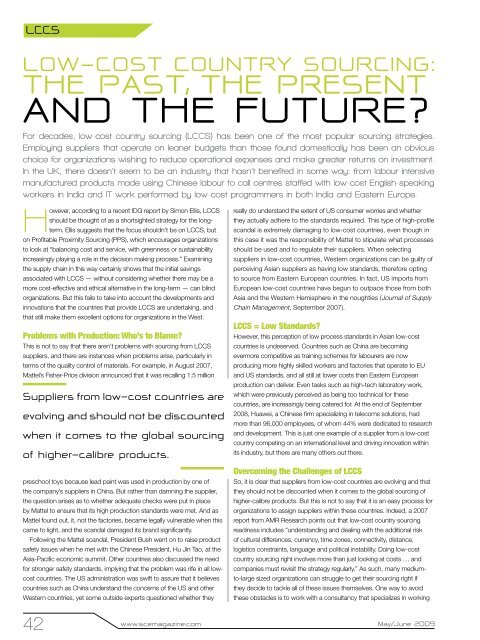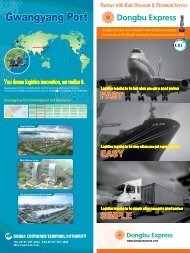w w w . s c e m a g a z i n e . c o m - Supply Chain Europe
w w w . s c e m a g a z i n e . c o m - Supply Chain Europe
w w w . s c e m a g a z i n e . c o m - Supply Chain Europe
Create successful ePaper yourself
Turn your PDF publications into a flip-book with our unique Google optimized e-Paper software.
LCCS<br />
loW-cost country sourcing:<br />
the past, the present<br />
and the Future?<br />
For decades, low-cost country sourcing (LCCS) has been one of the most popular sourcing strategies.<br />
Employing suppliers that operate on leaner budgets than those found domestically has been an obvious<br />
choice for organizations wishing to reduce operational expenses and make greater returns on investment.<br />
In the UK, there doesn’t seem to be an industry that hasn’t benefited in some way: from labour-intensive<br />
manufactured products made using Chinese labour to call centres staffed with low-cost English-speaking<br />
workers in India and IT work performed by low-cost programmers in both India and Eastern <strong>Europe</strong>.<br />
However, according to a recent IDG report by Simon Ellis, LCCS<br />
should be thought of as a shortsighted strategy for the longterm.<br />
Ellis suggests that the focus shouldn’t be on LCCS, but<br />
on Profitable Proximity Sourcing (PPS), which encourages organizations<br />
to look at “balancing cost and service, with greenness or sustainability<br />
increasingly playing a role in the decision making process.” Examining<br />
the supply chain in this way certainly shows that the initial savings<br />
associated with LCCS — without considering whether there may be a<br />
more cost-effective and ethical alternative in the long-term — can blind<br />
organizations. But this fails to take into account the developments and<br />
innovations that the countries that provide LCCS are undertaking, and<br />
that still make them excellent options for organizations in the West.<br />
Problems with Production: Who’s to Blame?<br />
This is not to say that there aren’t problems with sourcing from LCCS<br />
suppliers, and there are instances when problems arise, particularly in<br />
terms of the quality control of materials. For example, in August 2007,<br />
Mattel’s Fisher-Price division announced that it was recalling 1.5 million<br />
suppliers from low-cost countries are<br />
evolving and should not be discounted<br />
when it comes to the global sourcing<br />
of higher-calibre products.<br />
preschool toys because lead paint was used in production by one of<br />
the company’s suppliers in China. But rather than damning the supplier,<br />
the question arises as to whether adequate checks were put in place<br />
by Mattel to ensure that its high production standards were met. And as<br />
Mattel found out, it, not the factories, became legally vulnerable when this<br />
came to light, and the scandal damaged its brand significantly.<br />
Following the Mattel scandal, President Bush went on to raise product<br />
safety issues when he met with the Chinese President, Hu Jin Tao, at the<br />
Asia-Pacific economic summit. Other countries also discussed the need<br />
for stronger safety standards, implying that the problem was rife in all lowcost<br />
countries. The US administration was swift to assure that it believes<br />
countries such as China understand the concerns of the US and other<br />
Western countries, yet some outside experts questioned whether they<br />
42<br />
really do understand the extent of US consumer worries and whether<br />
they actually adhere to the standards required. This type of high-profile<br />
scandal is extremely damaging to low-cost countries, even though in<br />
this case it was the responsibility of Mattel to stipulate what processes<br />
should be used and to regulate their suppliers. When selecting<br />
suppliers in low-cost countries, Western organizations can be guilty of<br />
perceiving Asian suppliers as having low standards, therefore opting<br />
to source from Eastern <strong>Europe</strong>an countries. In fact, US imports from<br />
<strong>Europe</strong>an low-cost countries have begun to outpace those from both<br />
Asia and the Western Hemisphere in the noughties (Journal of <strong>Supply</strong><br />
<strong>Chain</strong> Management, September 2007).<br />
LCCS = Low Standards?<br />
However, this perception of low process standards in Asian low-cost<br />
countries is undeserved. Countries such as China are becoming<br />
evermore competitive as training schemes for labourers are now<br />
producing more highly skilled workers and factories that operate to EU<br />
and US standards, and all still at lower costs than Eastern <strong>Europe</strong>an<br />
production can deliver. Even tasks such as high-tech laboratory work,<br />
which were previously perceived as being too technical for these<br />
countries, are increasingly being catered for. At the end of September<br />
2008, Huawei, a Chinese firm specializing in telecoms solutions, had<br />
more than 96,000 employees, of whom 44% were dedicated to research<br />
and development. This is just one example of a supplier from a low-cost<br />
country competing on an international level and driving innovation within<br />
its industry, but there are many others out there.<br />
Overcoming the Challenges of LCCS<br />
So, it is clear that suppliers from low-cost countries are evolving and that<br />
they should not be discounted when it comes to the global sourcing of<br />
higher-calibre products. But this is not to say that it is an easy process for<br />
organizations to assign suppliers within these countries. Indeed, a 2007<br />
report from AMR Research points out that low-cost country sourcing<br />
readiness includes “understanding and dealing with the additional risk<br />
of cultural differences, currency, time zones, connectivity, distance,<br />
logistics constraints, language and political instability. Doing low-cost<br />
country sourcing right involves more than just looking at costs … and<br />
companies must revisit the strategy regularly.” As such, many mediumto-large<br />
sized organizations can struggle to get their sourcing right if<br />
they decide to tackle all of these issues themselves. One way to avoid<br />
these obstacles is to work with a consultancy that specializes in working<br />
www.scemagazine.com May/June 2009



